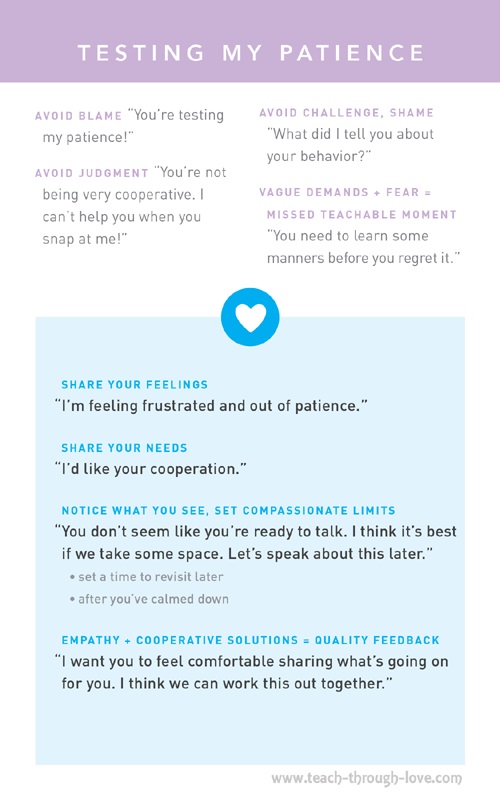A “Nagging” Situation
“Daddy doesn’t NEED me to get my shoes on. He WANTS me to get my shoes on!” my nine-year-old cried from behind the bathroom door.
Oh, how right she was!
My daughter, sensing her dad’s irritation and his fear of being late, had shut herself in the bathroom ignoring his “need” for her to finish getting ready for school.
He was rushed and tense, as the morning routine can elicit panicked appeals for cooperation from even the calmest parent.
No, he didn’t need her to put on her shoes. He wanted to feel responsible and needed to keep his commitments to be on time, and he was hoping she would contribute to this need by quickly dressing and meeting him at the door.
Nagging’s Impact
My daughter is extremely sensitive to my tone of voice and her mood can instantly and dramatically change if she perceives someone is stressed or angry.
Children naturally soak up the emotional environment around them and it can unconsciously affect their mood and behavior. When they are triggered into survival-brain thinking, it’s much more effective to respond to their perceived sense of stress, rather than argue the logic of the situation.
Better Ways to Handle the Situation
Talk about feelings
You sound worried that Daddy is blaming you for running out of time.
— He always rushes me. It’s not fair. —
You don’t like the feeling of being late either. I imagine that makes you more stressed.— YES, IT DOES! —
I think Daddy wants to be on time. He wanted you to help.— He should just say, “Can you please help me be on time and put on your shoes?” —
When our needs are cloaked in demands for obedience, we create resistance. As well-intentioned as we may be, our inclination to ask for cooperation by telling children that we “need” them to take action (to satisfy our responsibility, alleviate our feelings, or meet our needs) only produces more disconnection and defiance.
Slowly, our influence wanes and power-struggles set in.
Use emotions to build understanding
The problem is not with our true needs and emotions. It lies in how we communicate our needs and requests and the ways in which we share our emotions in an attempt to control the actions of others, rather than using emotion as a bridge to understanding.
Our kids want more from us than our directives and demands. They need more. They deserve more.
Children are learning about the world, how to gauge safety and danger, interpret social cues and understand cause and effect. The development of skills such as reflection and self-awareness rely on our quality feedback and safe, regulated experiences.
Is it possible to ask for cooperation or assistance from those we care about by sharing our real needs?
Create emotional safety
What does social emotional safety look like?
- connection
- contribution
- purpose
- self-awareness
- self-reflection
- accountability
- repair
If we’re using:
- intimidation
- fear
- threats
- guilt
- shame
- judgment
- criticism
– then we’re stuck in reactive mode, affirming for our children that disconnection is an acceptable tool for meeting our needs.
Model emotional intelligence
If children are to presume emotions to be normal and tolerable, and if they are to learn to ask for what they need in ways that others will positively respond to, we must model for them the appropriate expression of healthy emotions such as impatience, anger or frustration.

Children model what they live.
We can restore our emotional connection and be the example they need by responding to their needs for safety and care even before they’re able to shift their behavior.
The Situation Revisited
If I had reacted to my daughter’s behavior by matching her intensity and trying to prove a point or teach a lesson, I’d have led us down an unfortunate path of disconnection.
Instead, I became more curious and helpful, ignoring the negative energy and addressing the needs she was communicating.
I eventually asked, “Do you need a hug?” She said, yes and as I held her, I acknowledged that it looked like she was stuffing down some uncomfortable feelings, and I wanted to help her release them.
Instead of demanding disciplined behavior, I shared the gift of emotional safety and saw the return of a positive-minded, responsible child who happily contributed to the goal of getting out the door on time.
How do you speak to your children? Have you noticed when they’re more responsive to you? What makes the difference in your family?
By Lori Petro
Founder of Teach through Love
Teach through Love provides practical information, support, and tools to help parents reduce anger and frustration and increase cooperation and connection with their children. Includes free articles, online classes, support groups, and private sessions.
____________________________________________________________
For more information about this topic, check out the following books. Purchasing books from our website through Amazon.com supports the work we do to help parents do the best job they can to raise their children.
<recommended books about communication
<all our recommended parenting books
____________________________________________________________





